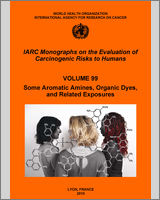NCBI Bookshelf. A service of the National Library of Medicine, National Institutes of Health.
IARC Working Group on the Evaluation of Carcinogenic Risks to Humans. Some Aromatic Amines, Organic Dyes, and Related Exposures. Lyon (FR): International Agency for Research on Cancer; 2010. (IARC Monographs on the Evaluation of Carcinogenic Risks to Humans, No. 99.)
2.1. Case report
Rehn (1895) was the first to report the appearance of bladder tumours in three of 45 workers involved in the manufacture of fuchsin in one factory in Germany. At the time, this process involved heating a mixture of chemicals, including toluidine, aniline and nitrobenzene to obtain crude fuchsin, which was men purified and crystallized. The three workers had been employed for 15–29 years. One worker developed a “fibroma papillare”, another an oedematous papilloma, and the third a carcinoma of the bladder.
2.2. Cohort studies
Case & Pearson (1954) surveyed workers employed for at least six months between 1910 and 1952 in the manufacture of magenta in the British chemical industry. Workers who had been exposed to benzidine or 1- or 2-naphthylamine were excluded. Bladder-cancer occurrence was determined from factory and hospital records. Deaths were identified from alphabetical lists of death certificates, and the numbers were compared with mortality rates for England and Wales for the period 1921–1952. Among 85 magenta production workers known to have been in contact with magenta, but not exposed to auramine, 1- or 2-naphthylamine or benzidine, there were five cases of bladder cancer, with exposure duration ranging from 1–19 years. Three of these cases were mentioned on death certificates, whereas only 0.13 would have been expected for the whole male population in England and Wales (SMR 23.1; P < 0.005). One case of bladder cancer was observed among nine subjects who had been exposed to both magenta and auramine, but no death was seen from this cause (0.02 expected). [The Working Group noted that during the manufacture of magenta exposure to other aromatic amines cannot be ruled out.]
Rubino et al. (1982) studied case-specific mortality of 53 male workers who had been employed for ≥ 1 month in the manufacture of ‘new fuchsin’ (Magenta III, Basic Violet 2, CI No. 42520) and Safranine T (Basic Red 2, CI No. 50240) during the period 1922–1970 in a factory in the province of Torino, Italy. Workers engaged in the manufacture and use of 1- or 2-naphthylamine or benzidine were excluded from the study. Subjects and their work histories were identified from factory personnel records, and the workers were followed for mortality from 1946 to 1976, as identified from factory records and from the municipal registries of their current residence. Among the 53 workers exposed, five deaths from bladder cancer were observed, while 0.08 were expected on the basis of mortality rates for Italy in 1951–76 (SMR 62.5; P < 0.001). The cases had been occupationally exposed to Magenta III and Safranine T for 12–40 years. The exposures also involved ortho-toluidine and 4,4′-methylenebis(2-methylaniline). The same cohort of workers was followed to the end of 1981 (Decarli et al., 1985) and further until 1989 (Piolatto et al., 1991). No additional deaths from bladder cancer were reported.
2.3. Case–control studies
A total of 512 male cases of bladder cancer and 596 hospital-based controls were studied for occupation and bladder-cancer risk during 1978–1983 in the province of Torino, Italy (Vineis & Magnani, 1985). Complete occupational histories and related information were obtained via hospital interviews. Exposures to specific chemicals, including magenta, were estimated from ILO occupation and industry titles, using information on the industrial uses of these chemicals as described in published sources. On the basis of industrial branches in which magenta exposure could have occurred, 41 cases were classified as having been exposed before the age of 60, to give a relative risk of 1.8 (95% confidence interval, 1.1–2.9). On the basis of job titles in which exposure to magenta could have occurred, two cases were classified as having been exposed before the age of 60, with an associated relative risk of 3.0 (95% confidence interval, 0.4–20.0).
- Studies of Cancer in Humans - Some Aromatic Amines, Organic Dyes, and Related Ex...Studies of Cancer in Humans - Some Aromatic Amines, Organic Dyes, and Related Exposures
- Exposure Data - Some Aromatic Amines, Organic Dyes, and Related ExposuresExposure Data - Some Aromatic Amines, Organic Dyes, and Related Exposures
Your browsing activity is empty.
Activity recording is turned off.
See more...
